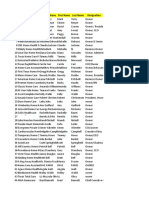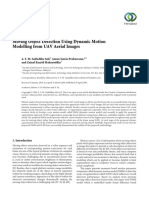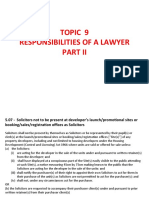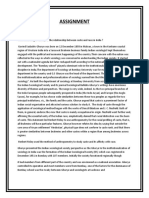Drone Rangers: Sustainability
Drone Rangers: Sustainability
Uploaded by
Clear MindCopyright:
Available Formats
Drone Rangers: Sustainability
Drone Rangers: Sustainability
Uploaded by
Clear MindOriginal Title
Copyright
Available Formats
Share this document
Did you find this document useful?
Is this content inappropriate?
Copyright:
Available Formats
Drone Rangers: Sustainability
Drone Rangers: Sustainability
Uploaded by
Clear MindCopyright:
Available Formats
60 AfricA speciAl SuStainability
Drones are already
being used to
monitor endangered
species in Nepal
Drone
With the worldwide trade in study carried out by the Wildlife “Given the overwhelming threat to
Conservation society, African forest
illegal ivory booming, many elephants, a species native to the Congo
elephants, rhinos and tigers – most threats
due to the illegal wildlife trade, WWF came
species are closer than ever to Basin, experienced a decline in population of up with a new approach: create an umbrella
extinction. Can drones help 62 per cent between 2002 and 2011. of technology to protect wildlife,” explains
authorities take on the fight elsewhere, rhinoceroses are similarly Crawford Allan, WWF’s expert on illegal
being driven to near extinction. A study wildlife trade.
against poachers? carried out by the International Union for “WWF will use its Global Impact Award
by Jason Goodyer Conservation of Nature found that poaching from Google to adapt and help governments
of the animals surged by 43 per cent between implement specialised aerial surveillance
For most people, mention of the word 2011 and 2012. last year, poachers killed 668 systems and affordable wildlife tagging
‘drone’ is likely to bring to mind images rhinos in south Africa, mainly in the Kruger technology, coupled with cost-effective
of Big Brother ‘eye in the sky’ spy planes, National park, which is home to the world’s ranger patrolling guided by analytical
sinister military airstrikes or even dystopian largest population of white rhino. software, to increase the detection and
terminator-style robot warfare. let’s face it, one of the primary reasons for this is the deterrence of poaching in four sites in Asia
drones, or UAVs (unmanned aerial vehicles) booming ivory trade in Asia. Despite it being and Africa.”
as they are sometimes known, don’t exactly well known that rhino horn is made of
have the cuddliest of public images. keratin, the same substance found in human Animal surveillance
However, if the World Wildlife Fund hair and fingernails, many people across the charity aims to develop and test
(WWF) has any say, perceptions may soon be China and Vietnam believe it to be a panacea sophisticated but cost-effective and
changing. last December, the charity capable of curing everything from erectile easily-replicable systems built around four
received a $5m grant as part of Google’s dysfunction to cancer. main components: aerial surveillance,
PHOtOGRaPHS anD inFOGRaPHiC: WWF
Global Impact Awards – an initiative the As the demand for the powdered rhino animal tracking systems, ground patrols
search giant says “aims to support nonprofits horn and elephant ivory used in traditional and the logging and analysis of data on the
using technology and innovation to tackle herbal medicines increases so do the prices movements of both animals and poachers.
tough human challenges”. It intends to use the poachers can sell them for. the situation traditionally, rangers have relied on
this money to establish a network of is so dire now that the WWF estimates the ground patrols and location intelligence to
technologically advanced protective illegal wildlife trade is worth somewhere in combat poaching. However, the distances
measures to fight the increasing problem of the region of $7bn-10bn a year. As more and they cover are vast and the resources they
poaching across Africa, and drones are a more money is involved, the sophistication have to do it with are comparatively scarce.
central part of their plan. of the technology and methods employed by UAVs not only allow the rangers to safely and
A look at the statistics shows that the help the poachers similarly increases. But the cheaply view any illegal activities which may
cannot come quickly enough. According to a WWF is fighting back. be taking place on the ground, but also give
Engineering & Technology June 2013 www.EandTmagazine.com
C2201_R14235_Feature_60.BK.indd 60 16/05/2013 14:39
61
INFOGRAPHIC
HOW TO STOP WILDLIFE
AERIAL
SURVEYOR
CRIME WITH TECHNOLOGY
1. FLIGHT CONTROL 2. EYE IN THE SKY
The command centre
launches the aerial
survey systems, sets 1 2 The aerial survey systems
detects poachers and tagged
animals on the groud and
up the flight path and
COMMAND
3
CENTRE
3. ACTION
The mobile law enforcement units MOBILE LAW
deploy to the interception point using ENFORCEMENT
satelite coordinates, details and UNITS
POACHING TAGGED
Rangers
images of suspects from the command
centre and the aerial survey systems. GANGS ANIMAL
them easier, faster access to the often Park rangers on ideas, the initiative in Africa is not without
difficult terrain they are required to cover. ground patrol in precedent. Last year, WWF introduced UAVs
To coordinate these elements the charity Gabon on Africa’s to Bardia National Parks in Nepal. Like
west coast
plans to use a brand new piece of software, Africa, Nepal is home to a number of
the spatial monitoring and reporting tool endangered species prized by poachers
(SMART). Developed by a group of global thanks to the high prices their bones and
conservation agencies, SMART acts as a other parts command. Among these, tigers,
central control system to measure, evaluate elephants and rhinos are particularly prized
and guide enforcement patrols. The software and, sadly, also particularly vulnerable.
is open source, non-propriety, The UAVs used in this initiative were
highly-modifiable and available to the GPS-enabled FPV Raptors. These are
conservation community for free. It will inexpensive model planes often used by
incorporate intelligence gathering as well as hobby aircraft builders and radio control
patrol data, and it will use innovative ways to enthusiasts and are small and light enough to
aid conservation managers in strategic be launched by hand. They have a wingspan
enforcement planning. It is also available in of around two metres and fly at a maximum
the native languages of many end users. altitude of around 200 metres on a
Feeding into this system will be data gleaned pre-programmed route of 28km. Each flight
from animal tracking systems based on takes around 50 minutes and cameras fitted
mobile GSM technology, aerial surveillance on board can take both still and video images
from UAVs, and also from rangers working of the ground. The WWF plans to use more
on the ground. sophisticated models in Africa.
“Basically, the animal tracking system It’s clear that initiatives like this may not
will help us know where the animals are,” be enough on their own to save some species.
says Allan. “The aerial vehicle will help to Groups such as the WWF need to work with
detect poachers, particularly at night, and governments in Africa and Asia to improve
the SMART system will allow for decisions to education, tighten border controls and
be made to deploy wildlife rangers and develop other new technologies to combat the
law enforcement in the most cost illegal wildlife trade as a whole. But despite
effective and safe way to the many bleak statistics, hope remains for
intercept and deter poachers the world’s fauna: Bardia National Park in
based on a range of analytics.” Nepal recently reported a positive increase
Despite many forward-thinking in its tiger population. *
www.EandTmagazine.com June 2013 Engineering & Technology
C2201_R14235_Feature_60.BK.indd 61 16/05/2013 14:40
You might also like
- Home Care AgenciesDocument48 pagesHome Care AgenciesSadd RahmanNo ratings yet
- $20 20 Pips Per Day Challenge CompoundingDocument2 pages$20 20 Pips Per Day Challenge Compoundingeulogiotaylan100% (1)
- Evidence Cross River GorillaDocument4 pagesEvidence Cross River Gorillaivt2504No ratings yet
- Remotely Piloted Aircraft Systems As A Rhinoceros Anti-Poaching Tool in AfricaDocument10 pagesRemotely Piloted Aircraft Systems As A Rhinoceros Anti-Poaching Tool in AfricaMária CalmeiroNo ratings yet
- Learning Activity 4 Evidence: The Cross River Gorilla Part ADocument4 pagesLearning Activity 4 Evidence: The Cross River Gorilla Part AEdier Jonathan Conde PalechorNo ratings yet
- Evidence Cross River GorillaDocument4 pagesEvidence Cross River GorillaLa Vida Nos SorprendeNo ratings yet
- Learning Activity 4 Evidence: The Cross River Gorilla Part ADocument4 pagesLearning Activity 4 Evidence: The Cross River Gorilla Part ADeivid Leonardo Gallo PascagazaNo ratings yet
- Evidence Cross River GorillaDocument3 pagesEvidence Cross River GorillaKatherine GarridoNo ratings yet
- Evidence Cross River Gorilla Gregori JimenezDocument3 pagesEvidence Cross River Gorilla Gregori JimenezJose Gregorio Jimenez GarciaNo ratings yet
- Armed Eld-RangersDocument7 pagesArmed Eld-RangersMária CalmeiroNo ratings yet
- Will Legal International Rhino Horn Trade Save Wild Rhino Populations?Document14 pagesWill Legal International Rhino Horn Trade Save Wild Rhino Populations?Anna LiNo ratings yet
- წიგნიDocument2 pagesწიგნიLika KenkebashviliNo ratings yet
- Evidence Cross River GorillaDocument3 pagesEvidence Cross River GorillaAnggie Nathalia M MorenoNo ratings yet
- Evidence Cross River GorillaDocument4 pagesEvidence Cross River GorillaRomario De JesúsNo ratings yet
- Chapter 7 - Drones and ConservationDocument8 pagesChapter 7 - Drones and ConservationΘανάσης ΝταλώσηςNo ratings yet
- Evidence - Cross - River - Gorilla GPAU Act. 4Document4 pagesEvidence - Cross - River - Gorilla GPAU Act. 4Carlos QuicenoNo ratings yet
- Evidence: The Cross River GorillaDocument4 pagesEvidence: The Cross River GorillaCarlos Fabian MesaNo ratings yet
- 3820-Article Text-6878-1-10-20190701Document9 pages3820-Article Text-6878-1-10-20190701Robert-DupontNo ratings yet
- Learning Activity 4 Evidence: The Cross River Gorilla Part ADocument3 pagesLearning Activity 4 Evidence: The Cross River Gorilla Part ASusana OriaNo ratings yet
- Evidence Cross River GorillaDocument4 pagesEvidence Cross River GorillaSHIRLEY YADIRA QUINTERO CONTRERASNo ratings yet
- Learning Activity 4 Evidence: The Cross River Gorilla Part ADocument3 pagesLearning Activity 4 Evidence: The Cross River Gorilla Part ACaterine Gómez ToroNo ratings yet
- Evidence The Cross River Gorilla 2Document4 pagesEvidence The Cross River Gorilla 2Diego MazueraNo ratings yet
- Evidence Cross River GorillaDocument3 pagesEvidence Cross River GorillabryanNo ratings yet
- OspreyDocument11 pagesOspreyEdouard LhomerNo ratings yet
- Evidence Cross River GorillaDocument4 pagesEvidence Cross River GorillaANGIE VANESSA PERALTA SILVANo ratings yet
- Case StudiesDocument6 pagesCase StudiesEmmie MassiasNo ratings yet
- Learning Activity 4 Evidence: The Cross River Gorilla Part ADocument4 pagesLearning Activity 4 Evidence: The Cross River Gorilla Part Ayeison ortegaNo ratings yet
- Evidence Cross River GorillaDocument4 pagesEvidence Cross River GorillaLuis Leonardo Romero GalvisNo ratings yet
- Evidence Cross River GorillaDocument3 pagesEvidence Cross River Gorillaclerma2014No ratings yet
- Learning Activity 4 Evidence: The Cross River Gorilla Part ADocument4 pagesLearning Activity 4 Evidence: The Cross River Gorilla Part Acristian24500No ratings yet
- Evidence Cross River GorillaDocument4 pagesEvidence Cross River GorillaAlonso DueñasNo ratings yet
- Evidence Cross River GorillaDocument4 pagesEvidence Cross River GorillaVick MJNo ratings yet
- Evidence Cross River GorillaDocument3 pagesEvidence Cross River GorillaKarolina PintoNo ratings yet
- Evidence Cross River GorillaDocument3 pagesEvidence Cross River GorillaJuan Carlos MendozaNo ratings yet
- Conservation Biology - 2024 - Rivera - Assessing The Risk of Overexploitation To A Tarantula Species in The Pet TradeDocument10 pagesConservation Biology - 2024 - Rivera - Assessing The Risk of Overexploitation To A Tarantula Species in The Pet Tradeliuyu.qmulNo ratings yet
- Learning Activity 4 Evidence: The Cross River Gorilla Part ADocument4 pagesLearning Activity 4 Evidence: The Cross River Gorilla Part Aingrid mateusNo ratings yet
- Learning Activity 4 Evidence: The Cross River Gorilla Part ADocument3 pagesLearning Activity 4 Evidence: The Cross River Gorilla Part ANerak Polo SallaNo ratings yet
- Learning Activity 4 Evidence: The Cross River Gorilla Part ADocument4 pagesLearning Activity 4 Evidence: The Cross River Gorilla Part AMarcela RodriguezNo ratings yet
- Evidence Cross River GorillaDocument3 pagesEvidence Cross River GorillaJesús ManuelNo ratings yet
- Evidence Cross River GorillaDocument4 pagesEvidence Cross River Gorillajohana ayalaNo ratings yet
- Learning Activity 4 Evidence: The Cross River Gorilla Part ADocument3 pagesLearning Activity 4 Evidence: The Cross River Gorilla Part AAndre PionNo ratings yet
- Paper Colston - Et - Al - 2023 Viability Analysis of Kordofan GiraffeDocument16 pagesPaper Colston - Et - Al - 2023 Viability Analysis of Kordofan GiraffebmuhindoNo ratings yet
- Learning Activity 4 Evidence: The Cross River Gorilla Part ADocument3 pagesLearning Activity 4 Evidence: The Cross River Gorilla Part AKatherinne AlvaradoNo ratings yet
- Evidence Cross River GorillaDocument4 pagesEvidence Cross River GorillajonathanNo ratings yet
- A Survey On Anti-Poaching Strategies: International Journal of Science and Research (IJSR) June 2014Document4 pagesA Survey On Anti-Poaching Strategies: International Journal of Science and Research (IJSR) June 2014Abraham Y MbeweNo ratings yet
- A2 Grant Proposal 1Document15 pagesA2 Grant Proposal 1api-746353673No ratings yet
- Learning Activity 4 Evidence: The Cross River Gorilla Part ADocument4 pagesLearning Activity 4 Evidence: The Cross River Gorilla Part AKaren LindaNo ratings yet
- Evidence Cross River GorillaDocument3 pagesEvidence Cross River GorillayurleidysNo ratings yet
- Evidence Cross River GorillaDocument3 pagesEvidence Cross River GorillafredyNo ratings yet
- De-Horning: Hornless Rhinos?Document3 pagesDe-Horning: Hornless Rhinos?agreykatoNo ratings yet
- The Major Threats For The Cross River Gorilla AreDocument3 pagesThe Major Threats For The Cross River Gorilla AreJohn Walter Yepes CortesNo ratings yet
- The Peregrine Fund Annual 2000Document36 pagesThe Peregrine Fund Annual 2000IsraelNo ratings yet
- Evidence: The Cross River Gorrilla Unid 4 English 5: Abril 2020Document5 pagesEvidence: The Cross River Gorrilla Unid 4 English 5: Abril 2020Anuar David Peñates ContrerasNo ratings yet
- Giraffa Vol 12 Sep 2007Document17 pagesGiraffa Vol 12 Sep 2007bmuhindoNo ratings yet
- Learning Activity 4 Evidence: The Cross River Gorilla Part ADocument4 pagesLearning Activity 4 Evidence: The Cross River Gorilla Part ALauren KimNo ratings yet
- WWF Species ConservationDocument6 pagesWWF Species ConservationRuthNo ratings yet
- Learning Activity 4 Evidence: The Cross River Gorilla Part ADocument4 pagesLearning Activity 4 Evidence: The Cross River Gorilla Part ABlanca Zoraida Mahecha BenitoNo ratings yet
- The Last Populations of Gorillas in The Wild!: GorillaDocument1 pageThe Last Populations of Gorillas in The Wild!: GorillaStela SilvaNo ratings yet
- An Overview On Locust Control Amp ResearchDocument2 pagesAn Overview On Locust Control Amp ResearchNarendra KumarNo ratings yet
- MSB Tourism GuidelinesDocument63 pagesMSB Tourism GuidelinesisaNo ratings yet
- Learning Activity 4 Evidence: The Cross River Gorilla Part ADocument3 pagesLearning Activity 4 Evidence: The Cross River Gorilla Part ATatiana PatiñoNo ratings yet
- Global Motion Assisted Low Complexity Video Encoding For UAV ApplicationsDocument12 pagesGlobal Motion Assisted Low Complexity Video Encoding For UAV ApplicationsClear MindNo ratings yet
- Vehicle Detection in Aerial Surveillance Using Dynamic Bayesian NetworksDocument8 pagesVehicle Detection in Aerial Surveillance Using Dynamic Bayesian NetworksClear MindNo ratings yet
- Zhuang Miao, Shan Zou, Yang Li, Xiancai Zhang, Jiabao Wang, Ming HeDocument4 pagesZhuang Miao, Shan Zou, Yang Li, Xiancai Zhang, Jiabao Wang, Ming HeClear MindNo ratings yet
- (Approved) : Preparatory Tillage 1Document1 page(Approved) : Preparatory Tillage 1Clear MindNo ratings yet
- Research Article: Moving Object Detection Using Dynamic Motion Modelling From UAV Aerial ImagesDocument13 pagesResearch Article: Moving Object Detection Using Dynamic Motion Modelling From UAV Aerial ImagesClear MindNo ratings yet
- 2018-19 BasmatiDocument1 page2018-19 BasmatiClear MindNo ratings yet
- In The Punjab For The Year 2018-19: Cost of Production of Irri (Paddy) Crop Estimate Under Average ConditionsDocument1 pageIn The Punjab For The Year 2018-19: Cost of Production of Irri (Paddy) Crop Estimate Under Average ConditionsClear MindNo ratings yet
- Vegetables Growing Calendar in Pakistan - Multan FarmsDocument4 pagesVegetables Growing Calendar in Pakistan - Multan FarmsClear Mind75% (4)
- 6-Mapping Crop Type Using Hyperspectral and Multispectral DatasetsDocument35 pages6-Mapping Crop Type Using Hyperspectral and Multispectral DatasetsClear MindNo ratings yet
- Foundation and Principles of Business EthicsDocument8 pagesFoundation and Principles of Business EthicsCamila EllaNo ratings yet
- Korean Air Vs Yuson DigestDocument3 pagesKorean Air Vs Yuson DigestYoly Baccay0% (1)
- Comparison of FATCA With IGA Model 1 & Model 2Document4 pagesComparison of FATCA With IGA Model 1 & Model 2Vitalii LiakhNo ratings yet
- Fflanila: L/epublic of Tbe IlbilippinesDocument45 pagesFflanila: L/epublic of Tbe IlbilippinesMonocrete Construction Philippines, Inc.No ratings yet
- Responsibilities Part IIDocument36 pagesResponsibilities Part IIFatin AisyahNo ratings yet
- Tortona vs. GregorioDocument30 pagesTortona vs. GregorioMeg VillaricaNo ratings yet
- Proforma Invoice - IC624Document1 pageProforma Invoice - IC624Abdulay RosaNo ratings yet
- Hanlon (2010)Document31 pagesHanlon (2010)Bambang HarsonoNo ratings yet
- Business Ethics and Social Responsibility Module 2 Grade 11 QTR 2Document19 pagesBusiness Ethics and Social Responsibility Module 2 Grade 11 QTR 2Justin AmorantoNo ratings yet
- LOC-Unit 1 (3 LLB)Document91 pagesLOC-Unit 1 (3 LLB)Sam Jasper 073No ratings yet
- Case Study Report: I. Problems IdentificationDocument3 pagesCase Study Report: I. Problems IdentificationFeelya MonicaNo ratings yet
- 203 Sanlakas Et Al VS ReyesDocument1 page203 Sanlakas Et Al VS ReyesVian O.No ratings yet
- Immediate download From War to Peace in the Balkans the Middle East and Ukraine Daniel Serwer ebooks 2024Document55 pagesImmediate download From War to Peace in the Balkans the Middle East and Ukraine Daniel Serwer ebooks 2024antildeihl94100% (1)
- X - S.SC - Sample Paper-4 QP - PT-III 2022-23Document7 pagesX - S.SC - Sample Paper-4 QP - PT-III 2022-23yashi.pohankerNo ratings yet
- Brain Drain To Brain Gain of The PhilippinesDocument1 pageBrain Drain To Brain Gain of The PhilippinesQueen CatastropheNo ratings yet
- Rana Plaza Incident OSHADocument14 pagesRana Plaza Incident OSHAMadiha JamalNo ratings yet
- Admission Policy 2020-2021Document8 pagesAdmission Policy 2020-2021Delel NasriNo ratings yet
- mg355 All PDFDocument24 pagesmg355 All PDFsyedsrahmanNo ratings yet
- Depreciation: Illustration 1 (Journal Entries)Document3 pagesDepreciation: Illustration 1 (Journal Entries)Navnidh KaurNo ratings yet
- Naruto d20 - GM's HelperDocument78 pagesNaruto d20 - GM's HelperJonathan DionNo ratings yet
- MHADA INFORMATION BOOKLET ENGLISH Chap-19Document5 pagesMHADA INFORMATION BOOKLET ENGLISH Chap-19Joint Chief Officer, MB MHADANo ratings yet
- Golden Ages of Athens - Prevod Na SRBDocument2 pagesGolden Ages of Athens - Prevod Na SRBandrijabaNo ratings yet
- Gelect 2 Sex Gender, and Sexuality ActivityDocument1 pageGelect 2 Sex Gender, and Sexuality ActivityAshera MonasterioNo ratings yet
- GS GHURYE - Somya SharmaDocument8 pagesGS GHURYE - Somya Sharmakumud gargNo ratings yet
- The Gujarat Government Gazette: ExtraordinaryDocument4 pagesThe Gujarat Government Gazette: ExtraordinaryDeep HiraniNo ratings yet
- 98 Haji Abdul Gani Khan V Union of India 13 Feb 2023 458867Document21 pages98 Haji Abdul Gani Khan V Union of India 13 Feb 2023 458867palaakansha1306No ratings yet
- Nelson Mandela HOTSDocument2 pagesNelson Mandela HOTSfakeman200011No ratings yet
- Aec 216Document1 pageAec 216Hazel Seguerra BicadaNo ratings yet


































































































